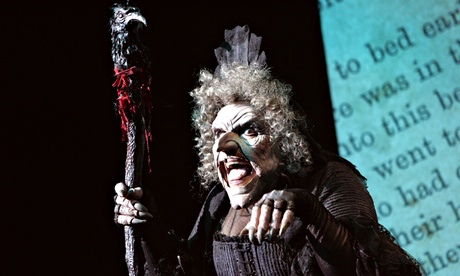
There are Sondheim shows that are showier, snappier, sarkier, sadder, and I love every one, but if I gotta pick, it has to be Into the Woods, soon to get the Hollywood treatment with Meryl Street as the old witch. It's Sondheim's plainest work, a default high-school production choice, with its plot a farce that turns to tragedy, patched from Grimmly trad fairytales augmented by a new story even less cheery. It's so plain that the pace of its music keeps returning to a steady trot of crochets and its great melodies work up and out from just two ascending notes on the words "I wish", through a five-note theme, simple as a child tonking a xylophone. These notes are played backwards, come together in a chord, and then extend into one of the most haunting final sequences in musical theatre.
I wasn't raised on fairytales – except as plot pretexts for pantos – but on musicals. Also musical comedy, operetta, and popular songs from the George Gershwin-Irving Berlin-Cole Porter era, with their complete narrative plus mood and characterisation in three minutes and 39 seconds flat. I liked it that all these were adult stories (even Rodgers and Hammerstein musicals, though less so than Rodgers and Hart), meaning they were often stories on their way to going wrong. I want – still do – my songs brave or torchy and my endings ambivalent. That's what music's for: sing it; survive it.
And there's the appeal of Into the Woods: its first act speeds through the fairytale plots (Cinderella entraps her Prince Charming, Jack kills the Giant and brings home the beans, etc) to arrive at an interval finale: Ever After. The second act begins with the words: "Once upon a time – later", and all the consequences of "I wish" come crashing down on the characters. Vengeful Mrs Giant descends the beanstalk to crush the human who done her man wrong; the princes compete over fresh trophy maidens; Red Riding Hood has defeated the wolf, but is left a frightened orphan, and not the only one onstage.
It all culminates in a marvelous finale based round the songs No One Is Alone and Children Will Listen. They're about love, not romance resolved, but the love of parents (and of an unwilling community forced to act in lieu of parents) for children. Sondheim has explained that the mood of this sequence –particularly as orchestrated by his regular collaborator Jonathan Tunick for a smallish Broadway cast – was meant to evoke the choruses of enchantment Walt Disney first introduced into his animated features in the 1940s. For three generations, they were the sound of the spell.
With Into The Woods, consider me spellbound, because this is where the hopeful truth of my childhood's musicals – we'll get by, we'll get out, maybe even get on – meets the abrupt bleakness of the fairytales. Both forms believe in singing it and surviving it. I gave the DVD of the original Broadway production to my honorary godchildren when they were of Disney-film age, and they've been hooked on Sondheim ever since. Job done.
More from musicals we love
• Andrew Haydon loves Meine Faire Dame
• Mirian Gillinson loves West Side Story
• Ryan Gilbey loves The Producers
• Michael Billington loves Sweeney Todd

